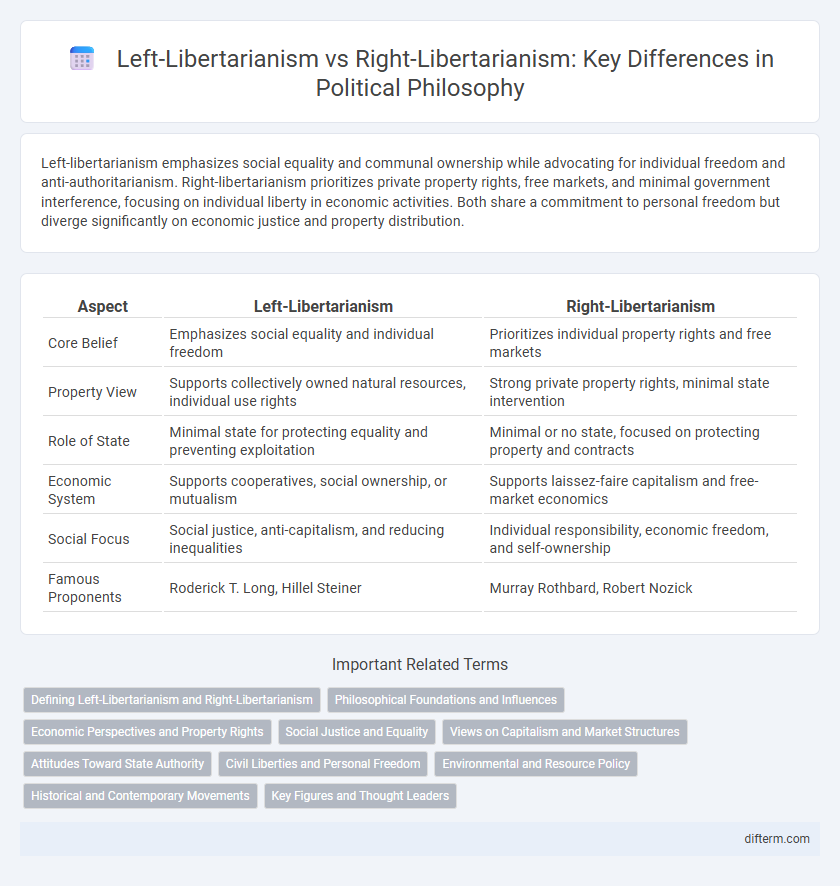Left-libertarianism emphasizes social equality and communal ownership while advocating for individual freedom and anti-authoritarianism. Right-libertarianism prioritizes private property rights, free markets, and minimal government interference, focusing on individual liberty in economic activities. Both share a commitment to personal freedom but diverge significantly on economic justice and property distribution.
Table of Comparison
| Aspect | Left-Libertarianism | Right-Libertarianism |
|---|---|---|
| Core Belief | Emphasizes social equality and individual freedom | Prioritizes individual property rights and free markets |
| Property View | Supports collectively owned natural resources, individual use rights | Strong private property rights, minimal state intervention |
| Role of State | Minimal state for protecting equality and preventing exploitation | Minimal or no state, focused on protecting property and contracts |
| Economic System | Supports cooperatives, social ownership, or mutualism | Supports laissez-faire capitalism and free-market economics |
| Social Focus | Social justice, anti-capitalism, and reducing inequalities | Individual responsibility, economic freedom, and self-ownership |
| Famous Proponents | Roderick T. Long, Hillel Steiner | Murray Rothbard, Robert Nozick |
Defining Left-Libertarianism and Right-Libertarianism
Left-libertarianism emphasizes social equality, communal ownership, and cooperative economics, advocating for the redistribution of resources to ensure fairness while preserving individual freedoms. Right-libertarianism prioritizes strong private property rights, free-market capitalism, and limited government intervention, promoting individual autonomy and economic liberty. Both ideologies value personal freedom but differ fundamentally on property rights and economic justice.
Philosophical Foundations and Influences
Left-libertarianism draws heavily on egalitarian principles and social justice theories, emphasizing collective ownership of natural resources and opposing hierarchical structures, influenced by thinkers like Pierre-Joseph Proudhon and Noam Chomsky. Right-libertarianism prioritizes individual property rights and free-market capitalism, grounded in classical liberal philosophy and shaped by figures such as John Locke and Robert Nozick. Both strains share a commitment to personal liberty but diverge fundamentally in their approaches to economic distribution and the role of state intervention.
Economic Perspectives and Property Rights
Left-libertarianism advocates for egalitarian economic structures emphasizing collective ownership or equal distribution of natural resources, prioritizing social justice and minimizing wealth inequality. Right-libertarianism champions strong private property rights, free markets, and minimal government intervention, promoting individual entrepreneurship and capital accumulation as foundations of economic freedom. Both perspectives agree on limiting state power but diverge sharply on the role of property rights and economic equity in a free society.
Social Justice and Equality
Left-libertarianism prioritizes social justice and equality by advocating for the redistribution of resources and dismantling systemic inequalities through communal ownership and cooperative decision-making. Right-libertarianism emphasizes individual property rights and free-market principles, often viewing social justice goals as secondary to personal freedom and minimal state intervention. The fundamental divide lies in left-libertarianism's focus on addressing structural oppression, while right-libertarianism centers on protecting private property and voluntary transactions.
Views on Capitalism and Market Structures
Left-libertarianism critiques traditional capitalism for perpetuating inequality and advocates for cooperative ownership or decentralized markets that emphasize social justice. Right-libertarianism supports free-market capitalism, prioritizing individual property rights and minimal state intervention to maximize economic freedom. Both ideologies value personal liberty but diverge sharply on how markets should be structured and regulated.
Attitudes Toward State Authority
Left-libertarianism advocates for minimal state interference while emphasizing social equality and collective ownership of resources, often supporting decentralized forms of governance to limit hierarchies. Right-libertarianism champions strong individual property rights and free-market capitalism, favoring a state role restricted to protecting private property and individual liberties. Attitudes toward state authority diverge sharply, with left-libertarians warning against capitalist exploitation enforced by the state, and right-libertarians viewing state intervention beyond protection as an infringement on freedom.
Civil Liberties and Personal Freedom
Left-libertarianism emphasizes extensive civil liberties combined with social justice, advocating for personal freedom alongside economic equality and communal ownership. Right-libertarianism prioritizes individual property rights and minimal state intervention, focusing on maximizing personal freedom with a strong defense of private ownership. Both ideologies champion civil liberties but differ fundamentally in balancing economic autonomy and social equality.
Environmental and Resource Policy
Left-libertarianism advocates for communal ownership or equitable sharing of natural resources, emphasizing environmental sustainability and social justice through decentralized, participatory decision-making. Right-libertarianism prioritizes private property rights and minimal state intervention, supporting free-market mechanisms to allocate resources and address environmental issues. The conflict centers on balancing individual liberty with collective responsibility for ecological preservation and resource management.
Historical and Contemporary Movements
Left-libertarianism historically roots itself in radical egalitarianism and anti-authoritarian socialism, as seen in movements like the Spanish Civil War's anarchist collectives and modern social ecology advocates. Right-libertarianism emerged from classical liberalism, emphasizing individual property rights and free-market capitalism, prominently represented by the American Libertarian Party and thinkers such as Robert Nozick. Contemporary debates highlight tensions between the left's focus on social justice and the right's prioritization of economic freedom and minimal state intervention.
Key Figures and Thought Leaders
Key figures in left-libertarianism include Noam Chomsky, who advocates for egalitarian social structures and anti-authoritarianism, and Michael Huemer, known for his emphasis on social justice and individual liberty. Prominent right-libertarian thinkers such as Robert Nozick and Murray Rothbard champion minimal government intervention, private property rights, and free-market capitalism. The distinct philosophical foundations of these leaders shape divergent approaches to liberty, state power, and economic organization within the libertarian spectrum.
left-libertarianism vs right-libertarianism Infographic

 difterm.com
difterm.com